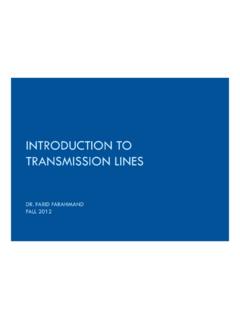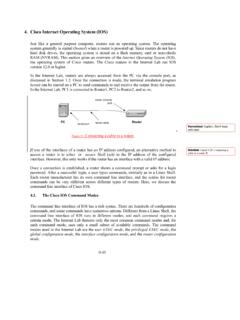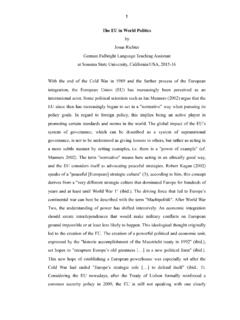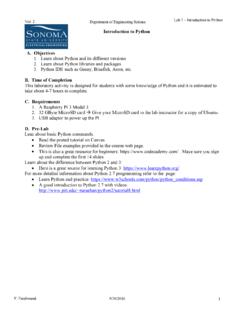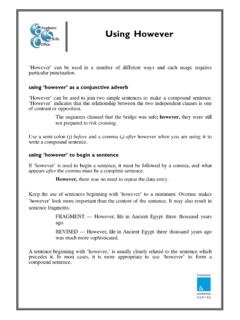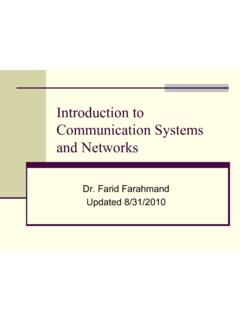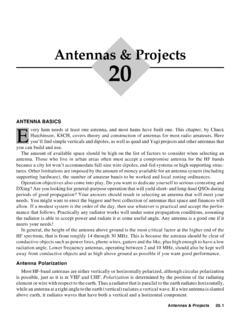Transcription of 2. TRANSMISSION LINES
1 2. TRANSMISSION LINES . TRANSMISSION LINES A TRANSMISSION line connects a generator to a load TRANSMISSION LINES include: Two parallel wires Coaxial cable Microstrip line Optical fiber Waveguide etc. TRANSMISSION line Effects Delayed by l/c At t = 0, and for f = 1 kHz , if: (1) l = 5 cm: (2) But if l = 20 km: Dispersion and Attenuation Types of TRANSMISSION Modes TEM (Transverse Electromagnetic): Electric and magnetic fields are orthogonal to one another, and both are orthogonal to direction of propagation Example of TEM Mode Electric Field E is radial Magnetic Field H is azimuthal Propagation is into the page TRANSMISSION line Model TRANSMISSION - line Equations Remember: Kirchhoff Voltage Law: Vin-Vout VR VL =0.
2 Kirchhoff Current Law: Ae j = A cos( ) + Aj sin( ) Iin Iout Ic IG =0. cos( ) = A Re[ Ae j ]. Note: sin( ) = A Im[ Ae j ]. E ( z ) =| E ( z ) | e j z VL=L . di/dt Ic=C . dv/dt | e j |= 1. B. C = A + jB = tan ; | C |= A2 + B 2. A. TRANSMISSION - line Equations ac signals: use phasors TRANSMISSION line Equation in Phasor Form Derivation of Wave Equations TRANSMISSION line Equation First Order Coupled Equations! WE WANT UNCOUPLED FORM! attenuation constant complex propagation constant Phase constant Combining the two equations leads to: Second-order differential equation Wave Equations for TRANSMISSION line Impedance and Shunt Admittance of the line Pay Attention to UNITS!
3 Solution of Wave Equations (cont.). Characteristic Impedance of the line (ohm). Using: Proposed form of solution: It follows that: So What does V+ and V- Represent? Pay att. To Make sure you Direction know how we got this! Solution of Wave Equations (cont.). So, V(z) and I(z) have two parts: But what are Vo+ and Vo- ? In general (each component has Refer to Magnitude and Phase): Notes We are interested in Sinusoidal Steady-state Condition wave along +z because coefficients of t and z have opposite signs wave along z because coefficients of t and z have the same sign Solution of Wave Equations (cont.). Applet for standing wave: ~olness/www/05fall1320/ Example Verify the solution to the wave equation for voltage in phasor form: Note: Example 2-1: Air line Assume the following waves : V ( z, t ) = 10 cos(2 700 106 20 z + 5).
4 I ( z, t ) = cos(2 700 106 20 z + 5). Assume having perfect dielectric insolator and the wire have perfect conductivity with no loss Draw the TRANSMISSION line model and Find C and L . Section 2. TRANSMISSION line Characteristics line characterization Propagation Constant (function of frequency). Impedance (function of frequency). n Lossy or Losless If lossless (low ohmic losses). Very high conductivity for the insulator Negligible conductivity for the dielectric Lossless TRANSMISSION line If Then: Non-dispersive line : All frequency components have the same speed! What is Zo? Example Assume Lossless TL;. Relative permittivity is 4.
5 C =10 pF/m Find phase velocity Find L . Find Zo Notes-1. The Big Idea . ZL. V+o Zo Zin What is the voltage/current magnitude at different points of the line in the presence of load?? Voltage Reflection Coefficient Consider looking from the Load point of view At the load (z = 0): Reflection coefficient The smaller the better! Normalized load impedance Expressing wave in phasor form: Remember: If lossless no attenuation constant All of these wave representations are along the TRANSMISSION line Special line Conditions (Lossless). Matching line ZL=Zo =0; Vref=0. Open Circuit ZL=INF =1; Vref=Vinc Short Circuit Remember: ZL=0 =-1; Vref=-Vinc Everything is with respect to the load so far!
6 Notes Voltage Reflection Coefficient Pay attention! Normalized load impedance Example Example Example Notes We are interested to know what standing waves happens to the magnitude of the |V| as such interference is Finding Voltage Magnitude created! When lossless! Remember: standing wave is created due to interference between the traveling waves (incident & reflected). Note: When there is no REFLECTION Coef. Of Ref. =. 0 No standing wave! standing Wave Due to standing wave the received wave at the load is now different standing waves Finding Voltage Magnitude voltage magnitude due to interference Conjugate! This is standing wave!
7 Each position has a different value! voltage magnitude is the magnitude at the load? What Z=-d standing waves Finding Voltage Magnitude voltage magnitude at z= -d current magnitude at the source Let s see how the magnitude looks like at different z values! Remember max current occurs where minimum voltage occurs! standing Wave Patterns for 3 Types of Loads (Matched, Open, Short). No reflection, No standing wave Matching line ZL=Zo =0; Vref=0. Short Circuit ZL=0 =-1; Vref=-Vinc (angle /+ ). Open Circuit ZL=INF =1; Vref=Vinc (angle is 0). Remember max current occurs where minimum voltage occurs! Notes standing Wave Patterns for 3 Types of Loads (Matched, Open, Short).
8 No reflection, No standing wave BUTM atching . WHEN line DO. MAX.. & MIN. ZL=Zo =0; Vref=0. Short Circuit Voltages Occur? ZL=0 =-1; Vref=-Vinc (angle /+ ). Open Circuit ZL=INF =1; Vref=Vinc (angle is 0). Remember max current occurs where minimum voltage occurs! Notes standing Wave Pattern For Voltage: Max occurs when cos( ) = 1 . In this case n=0,1,2, . NOTE that the FIRST & SECOND. dmax are /2 apart Thus, First MIN happens /4 after first dmax And so on . Finding Maxima & Minima Of Voltage Magnitude S = Voltage standing Wave Ratio (VSWR). For a matched load: S = 1. For a short, open, or purely reactive load: S(open)=S(short) = INF where | |=1.
9 What is the Reflection Coefficient ( d) at any point away from the load? (assume lossless line ). At a distance d from the load: Wave impedance Example Notes Example Notes Wave Impedance Input Impedance Zd What is input voltage? At input, d = l: Short-Circuited line For the short-circuited line : ZL=0. At its input, the line appears like an inductor or a capacitor depending on the sign of Input Impedance Special Cases - Lossless What is Zin when matched? Short-Circuit/Open-Circuit Method For a line of known length l, measurements of its input impedance, one when terminated in a short and another when terminated in an open, can be used to find its characteristic impedance Z0 and electrical length Example Check your notes!
10 Power Flow How much power is flowing and reflected? Instantaneous P(d,t) = v(d,t).i(d,t). n Incident n Reflected Average power: Pav = Pavi + Pavr n Time-domain Approach n Phasor-domain Approach (z and t independent). n Re{I*(z) . V(z)}. Instantaneous Power Flow Average Power (Phasor Approach). Avg Power: Re{I(z) * V_(z)}. Fraction of power reflected! Example Assume Zo=50 ohm, ZL=100+i50 ohm; What fraction of power is reflected? 20 percent! This is | |^2. Notes The Smith Chart Developed in 1939 by P. W. Smith as a graphical tool to analyze and design TRANSMISSION - line circuits Today, it is used to characterize the performance of microwave circuits Complex Plane Smith Chart Parametric Equations Equation for a circle Parameteric Equation!
